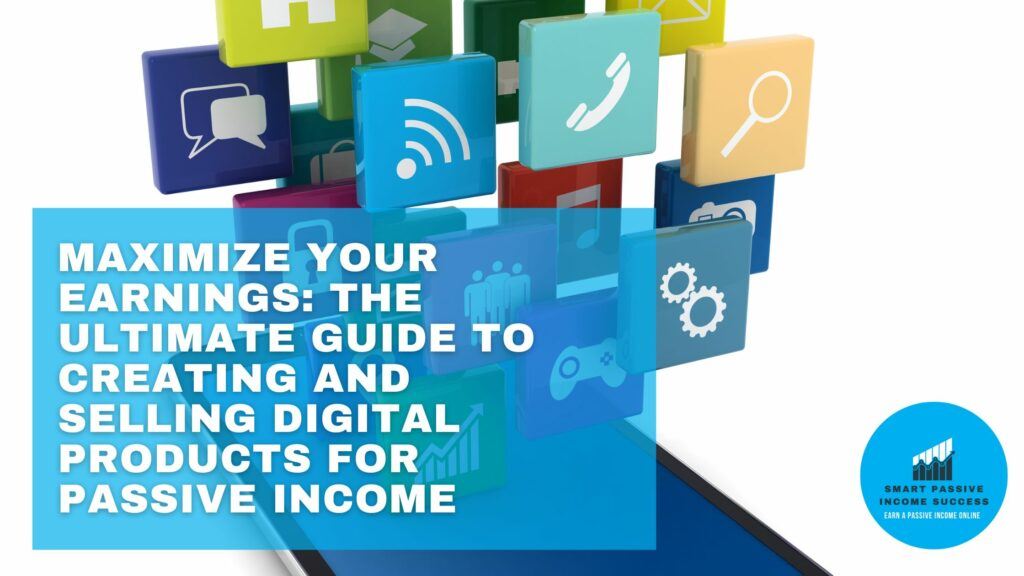When I mention passive income, I’m talking about money that’s earned with minimal effort on your part after the initial work is done. You’re not trading hours for dollars but rather leaning on the upfront work that continues to pay off over time.
Now, focusing on digital products, you tap into one of the most potent streams of passive income. These are resources like eBooks, courses, music, or software that you create once and sell indefinitely without the need for inventory restocking or physical delivery.
In a world where digital consumption is skyrocketing, innovation and creativity become your best friends. With a well-thought-out digital product, you can reach a global audience and earn revenue while you sleep, vacation, or work on other projects.
Up next, I’ll walk you through the critical step of pinpointing the perfect niche for your digital product. Getting this right lays the foundation for your success, ensuring you’re not only following your passion but also meeting a specific market need.
Table of Contents
Identifying Your Niche for Digital Product Creation

Picking a niche is where I urge you to BEGIN with CARE. Your niche is not just an area of interest but the very core that ensures your digital products resonate with potential buyers. Let me share some insights on the importance and selection.
RESEARCH is pivotal. Exploring trends is not about chasing what’s hot today; it’s about forecasting what others will still value tomorrow. Use platforms like Google Trends or social media to gauge what’s capturing attention. Supplement this with deeper dives into forums and community discussions.
Match trends with your EXPERTISE and PASSION. I can’t stress this enough: your chosen niche should align with your skills and knowledge. Authenticity in this aspect can give your products an edge. Look inward, outline your strengths, and map them to market opportunities.
Lastly, VET your niche against the competition. Fully understanding what others offer provides clarity on where your products can stand out or fill gaps. An ideal niche isn’t just a topic you love; it’s one where demand meets the unique value you can offer.
Designing and Creating Your Digital Product

After zeroing in on your niche, it’s time to roll up your sleeves and start the creation process. This is where your ideas take tangible form. I’m going to walk you through a simplified, actionable approach to bring your digital product to life.
1. Conceptualizing Your Digital Product
Start by outlining your product’s concept, including its purpose, target audience, and key features. Focus on the unique value or problem-solving aspect of your product.
Tip: Use tools like MindMeister for mind-mapping ideas or Trello for organizing and tracking your product development stages.
2. Choosing the Right Creation Tools
Select tools that align with the nature of your digital product.
- For eBooks: Consider Scrivener for drafting and Adobe InDesign for layout and design.
- For Online Courses: Use video creation tools like Camtasia or Adobe Premiere Pro for high-quality video production.
- For Apps: Explore platforms like Sketch for design and Xcode or Android Studio for development.
3. Producing Your Digital Product
Dive into the actual creation of your product. If you’re new to the tools, leverage online tutorials or courses.
Resource: Platforms like Udemy or Skillshare offer comprehensive courses on a wide range of creation tools.
4. Testing and Refining
Before the launch, thoroughly test your product and gather feedback for improvements.
Strategy: Use survey tools like Google Forms or SurveyMonkey to collect user feedback effectively.
5. Legal Considerations
Ensure all legal aspects such as copyrights, disclaimers, or terms of service are in place.
Tool: LegalZoom or Rocket Lawyer can be helpful for basic legal templates and advice.
6. Preparing for Launch
Now that your product is ready, plan for an impactful launch.
Next Step: The upcoming section will guide you through setting up an online presence to showcase and sell your digital product.
Setting Up Your Online Presence for Product Sales

You’ve poured your expertise and hard work into creating a digital product that you’re proud of. Now it’s time to introduce it to the world. Setting up an online presence is a crucial step in selling your digital products. It’s about making sure your product is not just visible, but also accessible and appealing to potential customers.
1. Launching Your Professional Website
In today’s digital marketplace, your website serves as the front door to your business, the first point of contact that can make or break a customer’s decision to engage with your product. A professional, user-friendly website is crucial in establishing trust and credibility. It’s not just about aesthetics; it’s about functionality and user experience.
Your website should be intuitive, easy to navigate, and visually appealing, ensuring that potential customers can find what they’re looking for with ease. Think of it as a digital handshake, where first impressions matter. It should reflect the quality and professionalism of your digital products, offering a seamless and engaging shopping experience.
Moreover, in an age where mobile browsing dominates, ensuring your website is responsive and accessible across all devices is non-negotiable. A well-designed website does more than showcase your products; it creates a customer journey that is efficient, enjoyable, and encourages repeat business.
Remember, in the realm of online sales, your website is not just a platform; it’s an integral part of the customer’s experience and a pivotal tool in your digital marketing arsenal.
- Key Aspects: Focus on a clean layout, easy navigation, and secure payment options.
- Engaging Content: Ensure product visuals and descriptions are clear and compelling.
- Tool Suggestions: Platforms like Shopify for e-commerce or WordPress with WooCommerce for more customization.
Related Resource: Looking for a comprehensive guide on how to launch your website with expert help?
2. Utilizing Social Media for Product Visibility
Social media platforms are not just communication channels; they are powerful tools for showcasing your products and building a vibrant community around your brand. Leveraging social media allows you to engage directly with your audience, creating a personal connection that can be pivotal in establishing trust and loyalty.
Platforms like Instagram, Facebook, Twitter, and LinkedIn offer unique opportunities to present your products dynamically and interactively. Through regular posts, captivating stories, and targeted ads, you can highlight the features and benefits of your digital products, while also giving a behind-the-scenes look into your creative process.
This approach not only enhances product visibility but also fosters a sense of community and belonging among your followers. Engaging with your audience through comments, polls, and direct messages makes your brand approachable and relatable, which is essential in converting followers into customers.
Furthermore, social media analytics provide invaluable insights into customer preferences and behaviours, enabling you to tailor your content and marketing strategies for maximum impact. In essence, effectively using social media is about creating conversations, not just broadcasting messages.
It’s about nurturing a community that values your digital products and looks forward to what you’ll share next.
3. Mastering SEO for Enhanced Discoverability
The significance of Search Engine Optimization (SEO) in driving organic traffic to your website cannot be overstated. In the vast expanse of the internet, SEO is the beacon that guides potential customers to your digital doorstep.
It’s about understanding and implementing the specific keywords and phrases that your target audience uses when searching for products like yours. By integrating these keywords strategically throughout your site – in product titles, descriptions, blog content, and even in image alt texts – you enhance your website’s visibility and searchability on search engines like Google.
Effective SEO practices ensure that your site appears higher in search results, thereby increasing the likelihood of clicks and visits. It’s not just about attracting more traffic, but about attracting the right traffic – people genuinely interested in what you have to offer.
Beyond keywords, SEO also involves optimizing your website’s user experience. Search engines favour sites that load quickly, are easy to navigate, and are mobile-friendly. Remember, good SEO is an ongoing process, not a one-time setup.
Regularly updating your content, staying abreast of the latest SEO trends, and continuously analyzing your site’s performance is crucial to staying ahead in the game.
By mastering SEO, you unlock the potential of organic search, one of the most cost-effective and sustainable ways to grow your online presence and customer base.
4. Keeping Customer Attention
Capturing the attention of potential customers is just the beginning; the real challenge lies in keeping them engaged and interested in what you have to offer. In today’s fast-paced digital world, consumer attention is fleeting, making it crucial to develop strategies that not only draw customers in but also encourage them to stay and explore.
This involves creating compelling, relevant content that resonates with your audience’s needs and interests. Regular updates, whether through blog posts, newsletters, or social media interactions, keep your audience informed and connected to your brand. Personalized experiences, such as targeted email marketing campaigns or customized offers, can significantly increase engagement by making customers feel valued and understood.
Additionally, fostering a community around your products through interactive platforms like forums, webinars, or social media groups encourages ongoing dialogue and builds a loyal customer base. It’s also vital to listen to your customers’ feedback and adapt your offerings accordingly, as this shows that you value their input and are committed to meeting their needs.
Remember, the goal is to turn initial curiosity into long-term loyalty by consistently providing value, maintaining relevance, and creating a dynamic, interactive experience that keeps your audience coming back for more.
- Customer Engagement: Tips on email marketing, retargeting ads, and creating compelling content.
- Tool Recommendations: Consider email marketing tools like Mailchimp or Constant Contact.
The right combination of a well-designed online store, strategic use of social media, and strong SEO practices puts you in an excellent position to attract and convert potential customers. However, the journey doesn’t end there. Once you’ve got their attention, you need to keep it.
Marketing Strategies for Your Digital Products

Now that your online presence is established, your next focus is on getting eyes on your digital products. Marketing isn’t just about shouting into the void and hoping someone hears you. It’s a strategic effort to reach potential customers where they are and convince them that your product meets their needs.
Start by putting together enticing descriptions. Each product you offer needs a blurb that is clear, informative, and speaks directly to your prospective customers’ needs and desires. Think about the problems your product solves and highlight those solutions prominently.
But creating a great product and crafting a perfect description isn’t enough if no one sees them. Content marketing can be a powerful tool here. Start a blog, create videos, or post on social media to share valuable information related to your niche. This builds trust, showcases your expertise, and keeps your product at the forefront of potential buyers’ minds.
Another vital tool is email marketing. Capture visitors’ email addresses with a lead magnet – something valuable that you give away for free in exchange for their contact details. Once you have a list, nurture it. Regular updates, personalized offers, and valuable insights help foster relationships and guide subscribers toward a purchase.
Throughout these efforts, remember to collect and display customer reviews and testimonials. They serve as social proof, reassuring others that your digital products are trusted and valued by real people. Positive feedback can significantly lift your credibility and sales.
Leveraging Affiliate Networks to Expand Reach and Sales

In the digital marketplace, your ingenuity and quality products are just the beginning. To see real growth in sales and to build a sustainable passive income, expanding your reach is essential. This is where affiliate networks come into play; they can amplify your efforts and help your products gain more visibility by tapping into a vast pool of potential buyers.
One such dynamic platform is Wealthy Affiliate. I have found it to be a sturdy bridge connecting digital creators like me with an enthusiastic affiliate community. Wealthy Affiliate simplifies the process of finding and collaborating with affiliates. It’s an ecosystem designed to nurture both creators and marketers, fostering growth and driving sales.
These networks work because affiliates receive a commission for every sale they generate, so they’re motivated to sell more of your products. It’s a win-win: you get higher sales, and affiliates get rewarded for their marketing efforts. The synergy created by this partnership is powerful, often bringing in a diverse audience you might not have reached alone.
To enhance your success with affiliate networks, start by selecting affiliates that align with your niche and values. After that, provide them with high-quality resources like banners, email templates, and even product samples that they can use in their marketing campaigns. And let’s not forget—communicate with your affiliates regularly to create lasting partnerships.
Remember, embracing affiliate marketing does not mean putting in less effort. You still need to maintain and update your digital products, provide excellent customer service, and stay savvy with marketing trends. Keep your digital products fresh, and work with your affiliates to ensure they remain excited and informed about what you’re offering.
If you’re ready to SCALE UP your digital product business and want a dependable partner for your affiliate marketing journey, Wealthy Affiliate stands out as a match. Just as your products solve problems for customers, Wealthy Affiliate can be the solution you’ve been looking for to solve your marketing and sales challenges.
For creators serious about growth and seeking continuous income, the affiliate network is not just an option—it’s an integral part of your business puzzle.
Turn Your Passion into Profits
Unlocking the Power of Passive Income: Your Next Steps in Digital Product Mastery
As we draw this guide to a close, it’s clear that creating and selling digital products offers a remarkable pathway to earning passive income. But remember, the journey doesn’t end with the creation and launch of your product. It’s an ongoing process of refinement, marketing, and adapting to the ever-evolving digital landscape.
Here are some final thoughts and actions to keep in mind as you embark on this exciting venture:
- Continuous Learning and Improvement: The digital world is always changing. Stay informed about the latest trends and technologies that can enhance your products and marketing strategies. This ensures your offerings remain relevant and appealing.
- Engage with Your Audience: Build a community around your products. Use social media, email newsletters, and your blog to keep the conversation going. Feedback from your audience is invaluable for improving your products and creating new ones that meet their needs.
- Monitor and Adapt: Keep an eye on your sales and marketing metrics. Tools like Google Analytics can provide insights into what’s working and what’s not, allowing you to adapt your strategies for better results.
- Expand Your Portfolio: As you grow, consider diversifying your product range. This can include variations of your existing products or entirely new offerings that complement what you already have.
- Collaborate and Network: Connect with other digital product creators and marketers. Networking can open doors to new opportunities, partnerships, and insights that can propel your business forward.
In conclusion, the world of digital products is a realm of endless possibilities. With creativity, persistence, and a willingness to learn and adapt, you can turn your digital creations into a robust stream of passive income.
Now, take these insights, apply them to your journey, and watch as your digital product empire flourishes!






